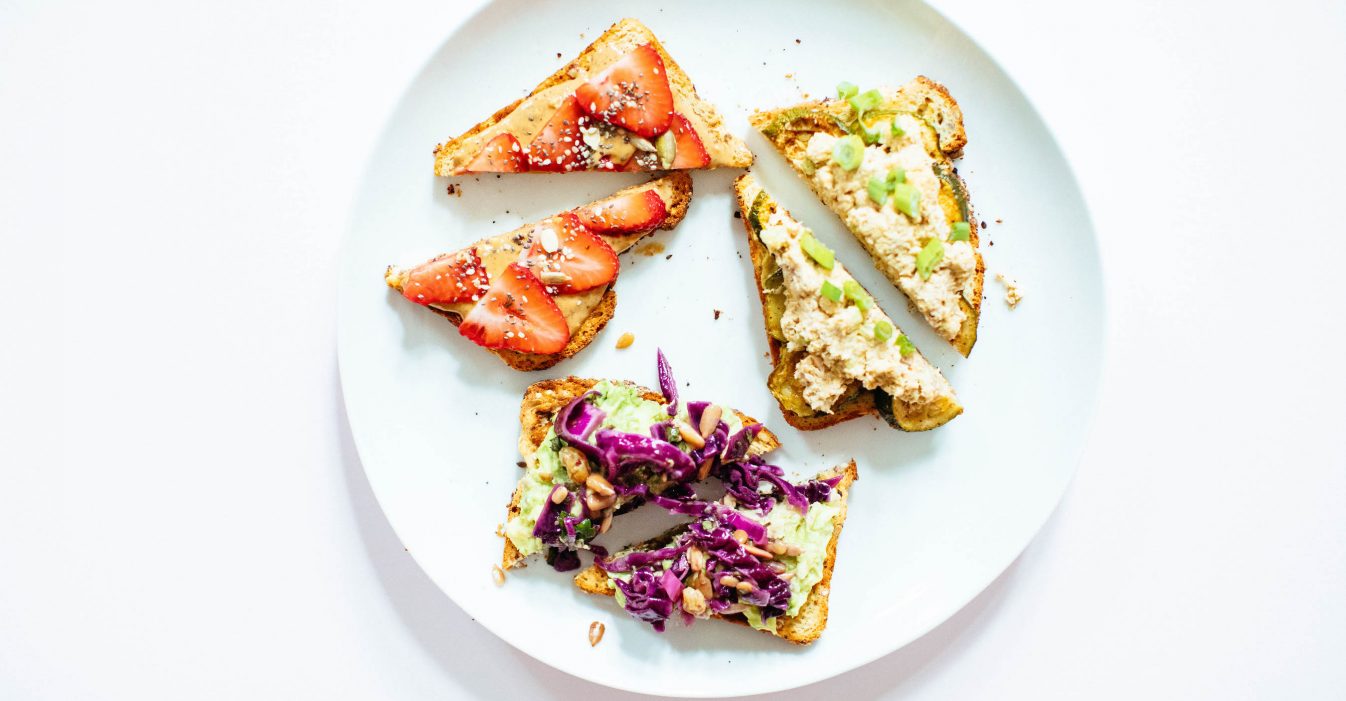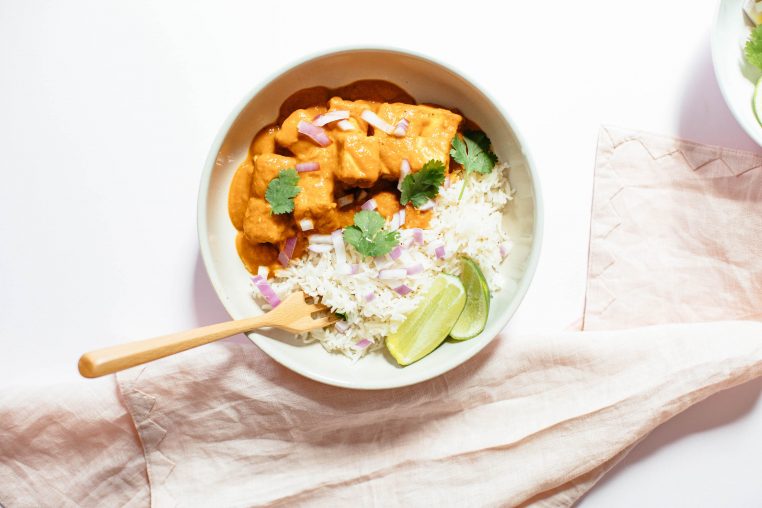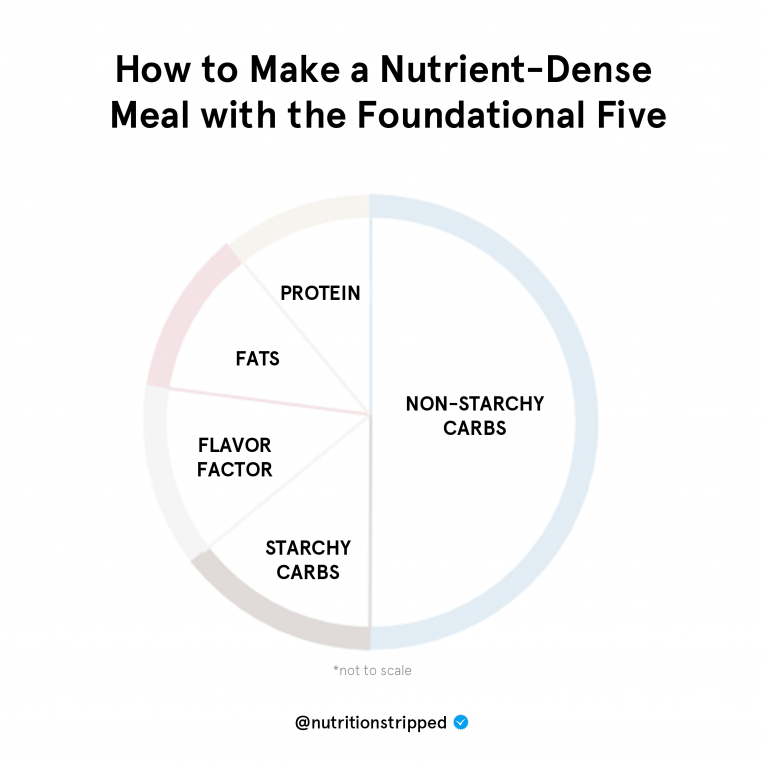Do you ever wonder if you’re serving up the right food portion size when you’re creating your snack or meal?
Portion sizes and serving sizes can be confusing.
- How much should I be eating?
- Should I follow the serving sizes?
- How do I know whether or not I need more than the “average” person?
These are just a few of the many questions I hear from the community daily!
In order for the nutrients you’re eating to do their job and fuel your body appropriately, we need to ensure we’re consuming the right amounts.
When you understand what food portion sizes your body needs, it helps you get the right balance of daily nutrients, which allows our bodies to feel their best on a daily basis and prevent chronic disease and health complications in the long run.
So in this article, you’re going to discover everything you need to know about portion sizes so you feel confident in how you’re nourishing yourself and know that you aren’t unknowingly over- or under-eating.
Portion Size Vs. Serving Size
The first thing you need to understand is the difference between portion sizes and serving sizes.
Oftentimes people use the words portion sizes and serving sizes interchangeably, but there’s actually a difference between the two.
What most people understand is serving sizes. Serving sizes are the guidelines that are found on nutrition labels for packaged food items.
They’re specific, standardized and measurable and are assigned serving sizes by the FDA based on generalized, recommended guidelines for what the average person eats.
Portion sizes, on the other hand, are individual to you, your needs, and what you choose to eat. There is no set, standard portion sizes. When you choose to eat a food item then physically take a particular amount, the amount of food on your plate is your portion size.
Why Eating the Right Portion Size is Important
Our bodies are quite literally made up of the food that we eat. We synthesize tissue, extract energy and perform bodily functions as a result of the nutrients we receive from food.
Consuming too much food or not enough food can alter these necessary processes and lead to complications later down the road.
On one hand, if you’re perpetually under-eating or not getting enough of certain foods, you are likely lacking vital nutrition which can cause fatigue, lethargy, muscle loss, hair loss, brittle nails, irritability and excessive thirst over time.
On the other hand, consistently over-eating can also make your body feel less than its best and cause a number of symptoms like unintentional weight gain, high cholesterol, high blood sugar, heart disease and many more.
Taking the time to determine what portion sizes are right for you in alignment with your health and wellness goals can make all the difference in how you feel and function daily.
1. Helps You Get The Right Balance Of Daily Nutrients
When we have the right balance of nutrients, our bodies are able to function their best. This is one of the best ways we can prevent chronic disease and health complications in the long run.
2. Keeps You Feeling Full and Energized
When we’re not eating enough food over the course of the day, we’ll consistently feel a slight sense of hunger. This can lead to irritability and even anxiety. On the other hand, when we eat too much over the course of the day, instead of feeling hungry and irritable we can feel overly full and lethargic. The goal is to eat the right portion sizes for your individual body which allows you to feel satiated and energized!
3. No Food Items Are Off Limits
The more you understand portion sizes that work for you, the more you understand that you don’t have to completely remove or restrict food items from your diet. It’s perfectly fine to enjoy food items in moderation that may not necessarily be the most nutritious option. Understanding and getting comfortable with portion sizes gives you the confidence and clarity you need to find a happy medium with your health and wellness.
6 Steps to Find the Right Portion Size for What You Need at Each Meal
Portion sizes are individual to each and every person on any given day. Dinner yesterday maybe a little smaller than it is today — and that is perfectly fine!
Contrary to most people’s beliefs, food portion sizes generally aren’t one of the first few things that we tackle.
Understanding portion sizes involves so much more than just knowing the numbers or hard facts, it’s about becoming in-tune with your body.
One of our members came to us after having tried just about everything — from calorie and macronutrient counting with apps to meal plans and diet programs, she just couldn’t seem to figure out a way to keep her portion sizes under control.
Despite the fact that she wanted to talk about portion sizes right off the bat, we instead discussed mindful eating and how she could use it to re-acclimate herself to her hunger and satiety cues. We then discussed her wellness goals as well as her usual activity and how these factors may impact her hunger cues and subsequently her portion sizes.
By taking a step back and looking at the big picture, she was able to understand that her hunger wasn’t the enemy, but rather the key to her success with portion sizes.
Use this same approach by utilizing the following 6 steps to determine what portion sizes are right for you.
1. Start by Checking In With Your Hunger And Satiety Cues
This one will always be most important.
When do you usually feel hungry? How full are you after meals? Are you truly satiated or do you usually feel hungry again after just an hour or so?
Get to know your hunger cues. Take a look at your usual habits and tendencies with a lens of curiosity, simply taking a moment to reflect can give you so much information for how you should proceed.
If you find that you’re uncomfortably full after most meals, slightly reduce your portion sizes and reassess. If you find that you’re hungry very soon after a meal, try increasing your portion sizes and go from there.
It’s all about your individual body and individual needs.
2. Practice Mindful Eating
Often times eating becomes just another task on a to-do list for people. It’s something we need to quickly do to get on with our day.
Unfortunately, this approach to eating can often lead to mindless eating over time. This is when we stop truly experiencing, tasting and appreciating our food. This can also lead to larger or smaller portion sizes than we really need.
Take some time to bring mindfulness back into your mealtimes. This is a great resource for you to use while attempting this!
3. Take Your Daily Activity Into Account
Your activity impacts your energy needs. Are you frequently moving around throughout the day? Or are you primarily sedentary? The more we are moving, the more energy we need.
You may find that this often fluctuates, therefore your portion sizes will fluctuate as well. Always be sure to acknowledge your movement and how that impacts your hunger and satiety.
4. Determine Your Strengths And Weaknesses
We all have both strengths and weaknesses, especially when it comes to portion sizes. Be sure to determine what yours are and address them as best as you can.
For example, if you know that after you’ve gone 5+ hours without food you no longer have control over your portion sizes, try not to set yourself up to fail! Be sure to have a snack to help hold you over, even if that means packing or prepping something in advance.
5. Use Your Plate As A Guide
Generally speaking, certain food items and macronutrients are associated with larger or smaller portion sizes. A great way to use this to your advantage is to use these general guidelines as a starting point.
The following visual is a generalized recommendation for how much of each component we should have on our plate.
Will this guide stay the same for everyone? Of course not. But it can be a great place to begin if you’re just getting started!
Common Mistakes People Make with Portion & Serving Sizes
As you’re learning portion sizes, there are a couple common mistakes people make when learning them all on their own. Let’s go through some of the most common ones so you can actively avoid them!
1. Attempting To Always Make Portion Sizes Exact
When making a lifestyle change and attempting to reach health and wellness goals, this is one of the first mistakes many people make.
It can be so easy to become hyper-focused on exact portion sizes, but in reality, it truly isn’t necessary. If we’re constantly attempting to make portion sizes exactly by using measuring cups, spoons, and scales, the lifestyle you were attempting to make will quickly become a rigid diet.
It’s important to be cognizant of your portion sizes, but perfection just doesn’t exist — so why stress yourself out over it? Use these tools to familiarize yourself with your portion sizes, then build your confidence with ball-parking and eyeballing from there.
2. Think Serving Sizes Apply To Everyone
Every packaged food product you purchase has a nutrition label on the back with predetermined serving size.
These serving sizes are based on the “average” American, with the assumption that they consume a 2,000 calorie diet. In reality, not everyone fits into this mold. Some people will need larger portion sizes, while others may need less.
While these serving sizes can be a great place to start, they should not necessarily dictate all of your portion sizes. This is where working with a registered dietitian can be helpful. Depending upon your particular health and wellness goals, they can tell you what portion sizes will look like for you in relation to listed serving sizes and how you can use them in a realistic, maintainable way.
3. Ignore Hunger And Satiety Cues
Sometimes it can be hard to trust yourself, especially when it comes to hunger and fullness.
Am I really hungry for more food, or do I just want it? How do I know if I’m actually full?
There are so many questions that run through our minds when it comes to determining how much to eat. Yes, we do want to think about portion sizes and be aware of them, but we also need to listen to our bodies.
Our hunger and satiety cues are the body’s way of telling us that we’re in need of energy or have had enough energy. When we’re not in-tune with these cues, it can be easy to over-eat or under-eat because we’re following strict portion guides instead.
4. Always Keep Portion Sizes The Same
Once we know what portion sizes we should be eating, they should be the exact same all the time, right? Not exactly.
We eat to fuel our bodies. Some days we need minimal fuel, other days we may need quite a bit more. For example, if you’re hiking, running or working outside in your yard – you’re going to need larger portion sizes than if your hanging inside watching movies all day.
Additionally, health and wellness goals need to be taken into account. Are you looking to gain muscle? Or maybe you’re trying to maintain your weight – this will also come into play when determining portion sizes as well.
Just remember that your day-to-day activities and goals will alter your energy needs from time to time.
Putting This Into Practice
We are all so unique as individuals and our day-to-day lives are so different. Our needs are so individualized and are constantly changing.
That’s why it so important for you to learn how to become more mindful of your body and its own needs to best support yourself.
While it takes patience and practice to fully be in tune with your body, you are deserving of having the confidence that you’re caring for your health in the best way.









